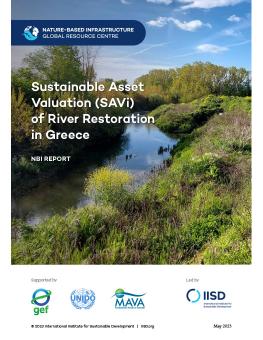
Sustainable Asset Valuation (SAVi) of River Restoration in Greece
This report presents a Sustainable Asset Valuation (SAVi) of nature-based, hybrid and conventional infrastructure for addressing flood risks in the region of Thessaly, Greece. We use spatial models, system dynamics modelling, and economic analysis to holistically assess the social, economic, and environmental benefits of restoring floodplains and riparian forests, building small retention dams, and expanding conventional dikes. The economic valuation demonstrates that the river restoration can provide diverse benefits such as carbon storage, increased agricultural production, and improved habitats for biodiversity.
Thessaly is an agricultural region in Greece that faces frequent floods, water scarcity, declining water quality, soil degradation, and loss of natural habitats. The region is expected to get hotter and drier as climate changes, and flooding is projected to continue in the future which will exacerbate water management challenges.
We used the Sustainable Asset Valuation (SAVi) methodology to holistically assess the social and environmental outcomes of the NBI compared to grey infrastructure that provides similar flood risk reduction benefits. The assessment combines a spatially explicit analysis with a system dynamics model to quantify the outcomes of three scenarios:
- Nature-based infrastructure (NBI): Riparian forests and floodplain restoration are implemented.
- Hybrid infrastructure: Riparian forests and floodplain restoration are implemented, and small dams are built upstream to reduce sedimentation.
- Grey infrastructure: New dikes are built along the river channel.
Key results:
- The NBI intervention has the highest benefit-to-cost ratio over the next 25 years. The benefit-to-cost ratio of the NBI is 2.9, compared to 2.4 for the hybrid and 1.5 for the grey infrastructure.
- Even without considering the avoided flood damages, the additional benefits, such as increased agriculture production and avoided costs of emissions, are sufficient to justify the investment in the NBI. The net benefits would be even larger when considering avoided flood losses, particularly from extreme events.
- The carbon storage value of NBI, which is equal to EUR 12.8 million, is, on its own, larger than the costs of the NBI (EUR 6.8 million) and of the hybrid infrastructure (9.3 million). The NBI would also improve habitat quality and support biodiversity, which could provide recreational opportunities and improve agricultural productivity.
The report is complemented by technical appendices with methodological details about the system dynamics model and spatial analysis that were developed for the valuation.
Participating experts
You might also be interested in
Sustainable Asset Valuation of Ecosystem-Based Adaptation Measures in the Reventazón River Basin, Costa Rica
In this integrated cost-benefit analysis, the Nature-Based Infrastructure (NBI) Global Resource Centre demonstrates the potential of ecosystem-based adaptation to stabilize hydrology and ensure a reliable water and energy supply in the Reventazón region of Costa Rica.
Sustainable Asset Valuation of Reforestation in Uganda
In this integrated cost-benefit analysis, the Nature-Based Infrastructure Global Resource Centre demonstrates the potential of nature-based infrastructure (NBI) to improve climate-related flooding and landslides in Kasese, Uganda, through the Bring Back Our Trees reforestation project.
How Can We Work With Nature to Tackle Drought and Desertification?
Drought is one of the most devastating and pervasive challenges exacerbated by climate change. However, we can work to reduce its effects through nature-based solutions for land restoration and climate-smart agriculture.
Sustainable Asset Valuation of Land Restoration and Climate-Smart Agriculture in Burkina Faso
This integrated cost-benefit analysis demonstrates the potential of nature-based infrastructure to restore land and combat desertification, aiding communities with climate change adaptation and producing wide-reaching socio-economic benefits.